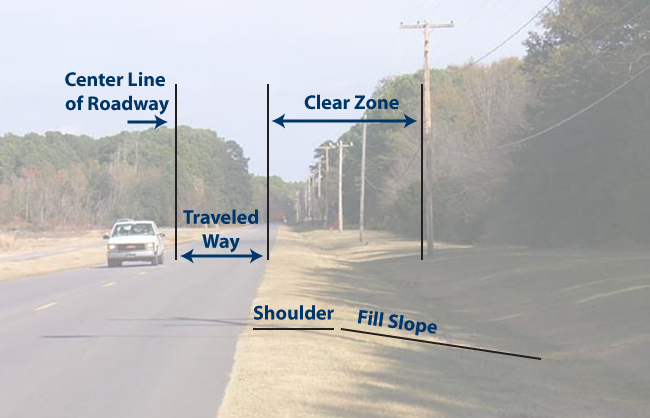The Clear Zone

The "forgiving roadside" concept recommends the development of a roadside "clear zone." A clear zone is the total roadside border area, starting at the edge of the traveled way, which is available for safe use by errant vehicles.
Clear Zone Distances
(in feet from edge of travel way)

The clear zone includes all areas along the roadside that are to be free of fixed objects and have slopes that may be safely crossed by a vehicle. The clear zone should be wide enough to allow a vehicle to regain control and return to the roadway or come to a controlled stop.
The design clear zone for a roadway is based on design speed, traffic volume, side slopes, roadway curvature, and site-specific conditions. The clear zone varies in width from 7 to 18 feet along low-speed roadways (40 mph or less) depending on ADT, from 10 to 28 feet along higher-speed facilities (45-50 mph), and up to as much as 46 feet along high-speed roadways including interstate highways.
Urban environments are characterized by sidewalks beginning at the face of the curb, enclosed drainage, numerous fixed objects (e.g., signs, utility poles, luminaire supports, fire hydrants, etc.), and frequent traffic stops. In these constrained settings, it is frequently not possible to obtain the appropriate clear zone shown above due to the limited right of way for roadside features, since urban areas are often more developed. When urban areas use curbing, fixed objects should never be located closer than 1.5 feet from the face of curbing, with 3 feet provided at intersections. This minimum lateral offset distance is intended only to provide sufficient clearance for the overhang of a truck to avoid striking an object, and should not be misconstrued as satisfying the clear roadside concept. In this setting, an enhanced lateral offset of 4 to 6 feet is more appropriate for this type of environment. The table below should be used in these constrained areas. These are reasonable goals when the clear zone widths shown above cannot be achieved, and should not be misconstrued as satisfying the clear roadside concept.
Urban Lateral Offset Distances



